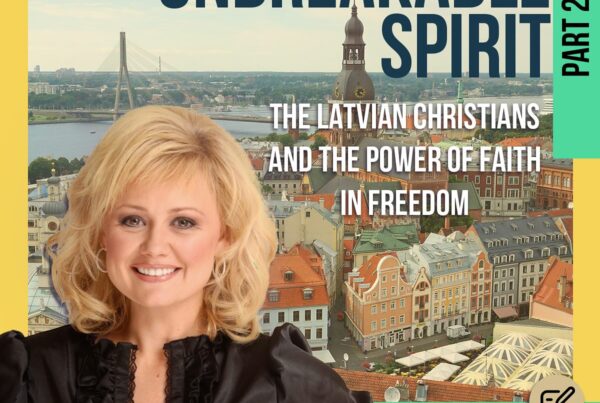Latvia’s Christian Heritage Amidst Soviet Suppression

Town square in Riga, Latvia
Thanks to the connections I made through the European Leadership Forum in Poland, I was invited by BridgeBuilders International—a mission ministry founded over 30 years ago by Latvian-American Charles Kelly—to lead the music track at the annual Christian Artists Camp. The camp, nestled near the beautiful shores of the Baltic Sea, is a gathering place for around 60 musicians and artists from Latvia and neighboring countries.


Angela receiving a hand-painted gift from President Emeritus Charles Kelly

Sunset on the Baltic Sea
Leading worship, teaching music masterclasses, and engaging with other ministry leaders at this camp was an enriching experience for me. Despite not speaking Latvian, I found that music is a universal language, and together, we forged deep bonds through our shared faith in Christ. I can play the piano in any language! 🎶

The band
Latvia itself is a land rich with history and breathtaking landscapes, but one of the most striking features was a cross by the river, a sacred reminder of believers who were baptized by Baptist missionaries in the 1850s.

This cross marks the place of the first believers’ baptism by Baptist missionaries in the 1850s
However, it was my conversation with Pastor Almer Ludviks that truly opened my eyes to the faith and resilience of the Latvian church. His story of ministry during the years of Soviet rule was captivating. Latvia’s history is one of struggle—through wars, occupations, and shifting powers, from Swedish and Polish invasions to the brutal purges of Stalin and the horrors of Nazi occupation. The people of Latvia, and particularly its Christian community, have faced unimaginable trials. And yet, faith endured.

Angela, Josh Masters and Pastor Almer Ludviks
When Communist rule began in Russia in 1917, religion was deemed an obstacle to the success of socialism. Karl Marx, coauthor of The Communist Manifesto, famously stated, “Communism begins where atheism begins.” Under Stalin’s brutal regime, militant atheism was imposed across the Soviet Union in an effort to extinguish religion altogether.
In the 1920s, the Salvation Temple Church in Riga, Latvia, thrived with a powerful revival, drawing over 5,000 worshippers. The country was ablaze with spiritual fervor, but in 1940, communism swept in like a cold tsunami, quenching that fire. The regime not only stifled the movement but also removed crosses and closed balconies, converting the church into a basketball hall. This drastic change ended a profound awakening that had united Latvians, Russians, Germans, and Poles in their shared hunger for God.
From 1928, Stalin launched the Godless Five-Year Plan, closing churches, synagogues, and mosques while imprisoning and executing thousands of religious leaders. The regime’s goal was clear: to replace “traditional national consciousness” (1) with a new socialist identity. Faith was portrayed as backward, superstitious, and a barrier to progress.

Demolition (by direct orders of Stalin) of the Cathedral of Christ the Savior in Moscow. December 5, 1931.
Latvia’s Christians, however, stood strong. Pastor Efraims Šmits of Salvation Temple in Riga remembers his father’s unwavering faith during these times. Despite threats from the KGB to scatter his 11 children to orphanages and separate him from his wife, offers of lucrative salaries to abandon his faith, and repeated interrogations, Janis Šmits remained resolute. When told he would be sent to prison, he simply replied, “Prisons need pastors too.”
Though many churches were destroyed, converted into museums of atheism, or left to ruin, faith persisted. The Soviet regime’s efforts to erase Christianity ultimately failed.
World War II deepened Latvia’s suffering. On June 14, 1941, thousands of Latvians, including children, were deported to Siberia. Nazi occupation followed, leading to the extermination of over 90,000 citizens, including ministers, priests, and people of faith. Yet, the Latvian church remained a beacon of hope for those who sought solace during those darkest times.
Latvia’s national identity was continually shaped by the harsh realities of war, occupation, and suppression. By the late 1980s, as discontent with Soviet rule grew, Latvia began pushing back.
But even during these periods of brutal suppression, the Soviets failed to extinguish the flame of Christian belief. Though heavily monitored, and often driven underground, the faith of many Latvian believers remained steadfast.
The harsh repression of faith under the Soviets persisted until Latvia’s struggle for independence culminated in anti-Soviet demonstrations in 1987. The road to freedom would not be easy, but the determination of the Latvian people remained strong until independence came.
The persecution faced by Latvian Christians during Soviet rule bears striking similarities to the trials encountered by the early church in the New Testament. The New Testament was written during a time of intense persecution, providing essential guidance for Christians facing adversity. In Ephesians 6:18, Paul emphasizes the importance of remaining vigilant and praying for all of God’s people, highlighting the power of collective support in times of trouble.
In 2 Thessalonians 3:1-2, Paul specifically requests prayers for the success of the gospel, linking it to his plea for deliverance from “wicked and evil men.” His desire to be rescued is not solely for personal safety; it is driven by his commitment to continue spreading the message of Christ. This underscores the vital role of prayer in both seeking protection and advancing the faith. By uniting in prayer, believers can fortify one another against external threats and encourage the ongoing mission of the church.
As a personal challenge, consider dedicating time this week to pray for the persecuted church globally. Reflect on their struggles, and intercede for their strength, courage, and unwavering faith amidst their trials. Your prayers can make a profound difference in their lives.
(1) Why Stalin Tried to Stamp Out Religion in the Soviet Union
Natasha Frost (https://www.history.com/author/natasha-frost)
https://www.history.com/news/joseph-stalin-religion-atheism-ussr
Date Accessed August 19, 2024
Publisher A&E Television Networks
Last Updated August 4, 2023
Original Published Date April 23, 2021







